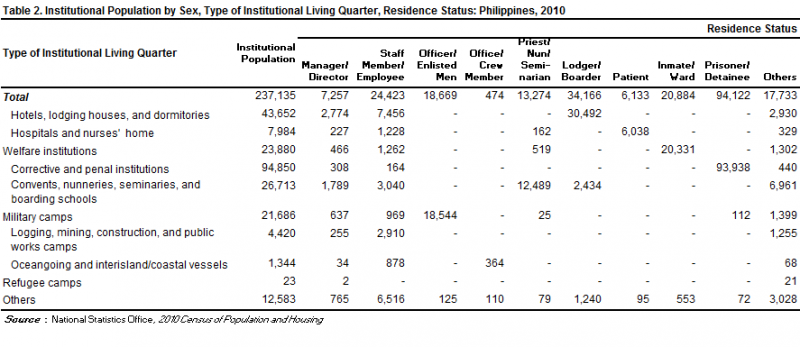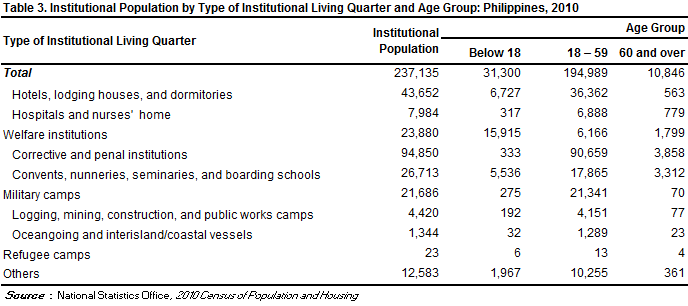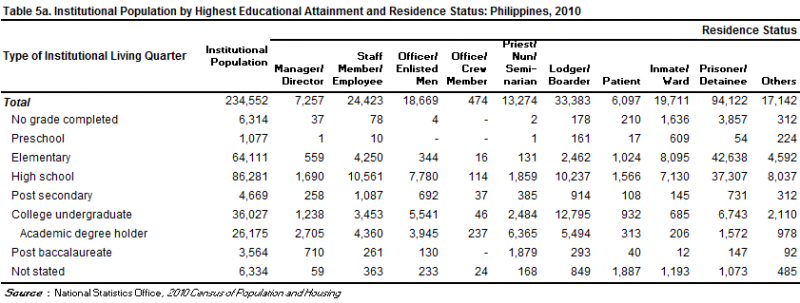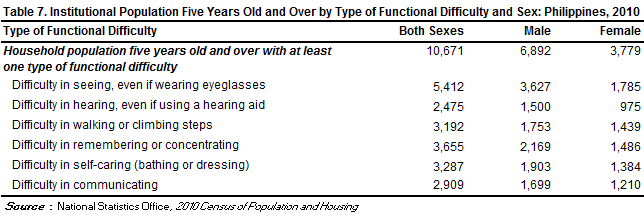Institutional population increased by more than 65 thousand
Institutional population constitutes that part of the total population whose usual place of residence are institutional living quarters (ILQs) such as hotels, lodging houses, and dormitories; hospitals and nurses’ homes; orphanages and welfare institutions; corrective and penal institutions; convents, nunneries, seminaries, and boarding schools; military camps; logging, mining, construction and public works camps; oceangoing, interisland, and coastal vessels; and refugee camps.
As of May 1, 2010, the institutional population of the country was posted at 237,135 persons, comprising 0.3 percent of the country’s total population of 92,337,852 persons in 2010. This figure is higher by 65,528 persons compared with the 171,607 institutional population that was reported in 2000. In 1990, the institutional population was 138,878 persons.
The number of institutions or ILQs, meanwhile, increased from 9,770 in 2000 to 14,851 in 2010. The number of ILQs in 1990 (11,403) was higher compared to that in 2000 (9,770).
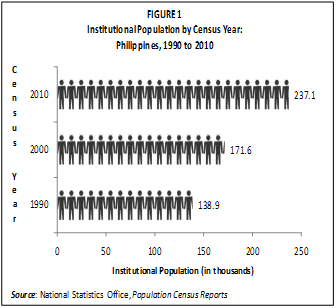
One in every two ILQs was a hotel, lodging house or dormitory
Hotels, lodging houses, and dormitories consistently comprised the largest number among the ILQs in the country in 1990, 2000, and 2010. This type of ILQ accounted for about half (49.9 percent) of the total number of ILQs in 2010. Convents, nunneries, seminaries, and boarding schools came in second (19.6 percent), followed by military camps (7.9 percent). These were also the top three most numerous ILQs in 1990 and 2000.
Further, oceangoing, interisland, and coastal vessels; and refugee camps registered the least number, contributing less than 0.5 percent each to the total ILQs in 2010. These types of ILQ have been the smallest in number since 1990.
During the period 2000 and 2010, the biggest increases in the number of ILQs were noted among hotels, lodging houses, and dormitories (3,982 or 116.2 percent); military camps (497 or 73.5 percent); and convents, nunneries, seminaries, and boarding schools (414 or 16.6 percent). On the other hand, a decrease was observed in the number of refugee camps (28 or -90.3 percent).
Two in every five institutional population resided in corrective and penal institutions
Among the various types of ILQs, corrective and penal institutions had the largest number of residents. Prisoners and detainees, managers, directors, persons-in-charge, staff members, and employees (including physicians and nurses) of such institutions comprised 40.0 percent of the total institutional population in 2010. ILQs with the second most number of residents were hotels, lodging houses, and dormitories (18.4 percent of the total institutional population); followed by convents, nunneries, seminaries and boarding schools (11.3 percent), welfare institutions (10.1 percent), and military camps (9.1 percent).
From 2000 to 2010, there had been increases in the population living in ILQs. Prisoners/detainees residing in corrective and penal institutions reached 93,938 persons in 2010, or an increase of 169.0 percent from the 34,915 prisoners/detainees reported in 2000. Inmates/wards residing in welfare institutions was posted at 20,331 persons in 2010, more than twice the 8,231 inmates/wards reported in 2000. Officers/enlisted men and trainees residing in military camps posted an increase of 75.6 percent, from 10,560 persons in 2000 to 18,544 persons in 2010. Patients residing in hospitals and nurses’ homes reached 6,038 persons in 2010, an increase of 71.4 percent from the 3,523 patients reported in 2000. Also posting an increase were lodgers/boarders residing in hotels, lodging houses, and dormitories, rising by 16.9 percent, from 26,082 persons in 2000 to 30,492 persons in 2010. In contrast, the number of priests, seminarians, and nuns residing in convents, nunneries, seminaries, and boarding schools decreased by 2.6 percent, from 12,827 persons in 2000 to 12,489 persons in 2010.
Managers and staff comprised 8.0 to 24.0 percent of residents in ILQs
There were managers, directors, staff members, and employees managing ILQs who were considered residents of these ILQs. For instance, in hotels, lodging houses, and dormitories, 17.1 percent were staff members and employees, including physicians and nurses; 6.4 percent were managers, directors, and officers-in-charge; and 69.9 percent were lodgers and boarders. Among the residents in hospitals and nurses’ homes, 15.4 percent were staff members and employees, including physicians and nurses; managers, directors, and persons-in-charge (2.8 percent); and 75.6 percent were patients. More than four fifths (85.1 percent) of the persons residing in welfare institutions, meanwhile, were inmates and wards, and the rest were staff members and employees, including physicians and nurses (5.3 percent); priests, seminarians, and nuns (2.2 percent); and managers, directors, and persons-in-charge (2.0 percent).
Moreover, nearly half (46.8 percent) of the persons residing in convents, nunneries, seminaries, and boarding schools were priests, seminarians, and nuns, and the rest were staff members and employees, including physicians and nurses (11.4 percent); lodgers and boarders (9.1 percent); and managers, directors, and persons-in-charge (6.7 percent). Among the 21,686 residents in military camps, 85.5 percent were officers, enlisted men, and trainees; 4.5 percent were staff members and employees, including physicians and nurses; and 2.9 percent were managers, directors, and officers-in-charge. In addition, there were also prisoners or detainees (0.5 percent) and priests, seminarians, and nuns (0.1 percent) who were reported residing in military camps.
Three fourths of ILQ residents were males
In 2010, nearly three in every four persons residing in ILQs were males (73.9 percent) while 26.1 percent were females. These figures resulted in a sex ratio of 283.3, or 283 males per 100 females. Males outnumbered females in all types of ILQ, except in welfare institutions, where females accounted for 51.8 percent while males comprised 48.2 percent, or a sex ratio of 93.0.
Males outnumbered females in oceangoing, interisland, and coastal vessels (98.1 percent were males); military camps (95.1 percent were males); corrective and penal institutions (92.8 percent were males); logging, mining, construction, and public works camps (87.6 percent were males); hospitals and nurses’ homes (58.3 percent were males); refugee camps (56.5 percent were males); convents, nunneries, seminaries, and boarding schools (53.1 percent were males); and hotels, lodging houses, and dormitories (52.3 percent were males).
In 2000, males comprised 62.5 percent of total institutional population in the country while females accounted for 37.5 percent. Females outnumbered males in welfare institutions (61.1 percent were females); hotels, lodging houses, and dormitories (52.8 percent were females); convents, nunneries, seminaries, and boarding schools (52.5 percent were females); and hospitals and nurses’ homes (51.0 percent were females).
Majority of the residents in welfare institutions were young
Of the 237,135 institutional population in 2010, approximately four in every five (82.2 percent) belonged to age group 18 to 59 years. The rest of the institutional population were aged 0 to 17 years (13.2 percent) and 60 years old and over (4.6 percent). In 2000, only about three fourths (76.4 percent) of the 171,607 institutional population were aged 18 to 59 years, while 19.1 percent belonged to age group 0 to 17 years and 4.5 percent were 60 years old and over.
By type of ILQ, two in every three residents in welfare institutions were aged 0 to 17 years (66.7 percent). The rest of the residents in these institutions were either 18 to 59 years old (25.8 percent) or 60 years old and over (7.5 percent). In contrast, majority of the residents in other types of ILQ belonged to age group 18 to 59 years: military camps (98.4 percent); corrective and penal institutions (95.6 percent); hospitals and nurses’ homes (86.3 percent); convents, nunneries, seminaries, and boarding schools (66.9 percent); and refugee camps (56.5 percent). Moreover, the percentage of institutional population aged 60 years old and over was highest in refugee camps (17.4 percent) and convents, nunneries, seminaries, and boarding schools (12.4 percent), and least in military camps (0.3 percent).
Majority of the officers, enlisted men, and trainees in military camps were married
Of the 230,831 institutional population aged 10 years old and over, about three fifths (63.2 percent) were never married while 29.7 percent were married. The rest of the institutional population was categorized as follows: in common-law/live-in marital arrangement (2.8 percent), widowed (1.6 percent), and divorced/separated (1.3 percent).
More than half (53.2 percent) of the officers, enlisted men, and trainees in military camps were married while 45.5 percent were never married. Among the prisoners and detainees in corrective and penal institutions, 47.2 percent were never married while 42.1 percent were married. Majority of the selected residents in other types of ILQ were also never married. As expected, almost all (98.1 percent) of the priests, seminarians, and nuns residing in convents, nunneries, seminaries, and boarding schools were never married. Inmates/wards in welfare institutions were mostly never married (86.5 percent). Never-married patients staying in hospitals and nurses’ homes, meanwhile, accounted for 64.4 percent of the total number of patients in these institutions.
Almost half of the priests, seminarians, and nuns residing in convents, nunneries, seminaries, and boarding schools were at least college degree holders
In 2010, 36.8 percent of the institutional population five years old and over had reached or completed high school and 27.3 percent had attended or graduated from elementary. College undergraduates and college degree holders comprised 15.4 percent and 11.2 percent, respectively, of the total ILQ residents.
Nearly half (48.3 percent) of the priests, seminarians, and nuns residing in convents, nunneries, seminaries, and boarding schools had graduated from college, 19.0 percent were college undergraduates, and 13.7 percent had pursued postbaccalaureate courses. Among the officers/enlisted men and trainees in military camps, 41.7 percent had reached or graduated from high school, 29.7 percent were college undergraduates, and 21.1 percent were college degree holders.
Moreover, among prisoners/detainees in corrective and penal institutions, 45.3 percent had reached or completed elementary while 39.7 percent had attended or finished high school. Among the inmates/wards in welfare institutions, 40.7 percent had reached or completed elementary while 36.7 percent had attended or finished high school. In hospitals and nurses’ homes, 25.6 percent of the patients had reached or completed high school, 16.7 percent had attended or finished elementary, and 15.1 percent were college undergraduates.
More than 4.0 percent of the institutional population had disability
More than 10,000 persons or 4.3 percent of the 237,135 institutional population in 2010 had disability. There were more males (64.5 percent) than females (35.5 percent) among the ILQ residents who had disability.
There were more males than females among those with functional difficulty
Of the 234,552 institutional population five years old and over, 4.5 percent (10,671 persons) had at least one type of functional difficulty either in seeing, hearing, walking or climbing steps, remembering or concentrating, self-caring (bathing or dressing), or communicating. There were more males (64.6 percent) than females (35.4 percent) among those persons with at least one type of functional difficulty.
Moreover, of the total 10,671 persons aged five years old and over with at least one type of functional difficulty, 50.4 percent reported difficulty in seeing, even if wearing eyeglasses; 34.3 percent had difficulty in remembering or concentrating; 30.8 percent had difficulty in self-caring (bathing or dressing); 29.9 percent had difficulty in walking or climbing steps; 27.3 percent had difficulty in communicating; and 23.2 percent had difficulty in hearing, even if using a hearing aid.

